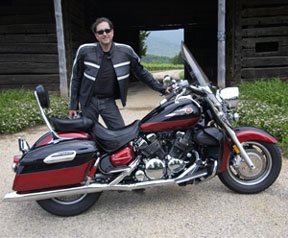The location was Willow Springs International Raceway. A dozen or so of us slightly weathered journalists had gathered to enjoy the clean air and warm sun of California's high desert and to spend some track time with Ducati's Redvolutionary 999: the slipperiest, slickest and speediest Duc Bologna's ever sold.
I'll call it an early holiday gift from Ducati, only because when I call it work, people groan. Thanks Ducati!
 Many, many laps and couple of days later, I was in a rented Saturn with my friend Mike Salisbury, motoring to Streets of Willow Springs for a day at Keith Code Superbike School. My lap times fell from 3:45 to 2:11 in one day, thanks to Keith and his team, especially my instructor,
Many, many laps and couple of days later, I was in a rented Saturn with my friend Mike Salisbury, motoring to Streets of Willow Springs for a day at Keith Code Superbike School. My lap times fell from 3:45 to 2:11 in one day, thanks to Keith and his team, especially my instructor,  Nancy "the Perfect Carrot" Montgomery, a strawberry blonde with piercing blue eyes. She would blow by me just close and fast enough to get my attention, then turn around and point to her tail, the universal signal for "follow me." As if there was ANY chance I wouldn't!
Nancy "the Perfect Carrot" Montgomery, a strawberry blonde with piercing blue eyes. She would blow by me just close and fast enough to get my attention, then turn around and point to her tail, the universal signal for "follow me." As if there was ANY chance I wouldn't!The setting sun signaled time for our good-byes. Mike navigated while I piloted the Saturn back to Venice Beach for a couple days touring the bike shops, surf shops and ethnic restaurants of Santa Monica. Ah, California, where life's a beach.
I had been in contact with the guys at Wild West Motorcycles, some two hours' ride away via freeway, and Mike had a Yamaha FJ1300. One Yamaha, two hours, and a handmade power cruiser sounded like an excellent recipe for mischief to me.
The Yamaha was fast, but I like my license and everywhere I looked were motorcycle-mounted police, mostly on BMWs and Harleys, but some local cops were riding Kawasakis. I gingerly toured toward Escondido.
The Wild West Motorcycle Company might as well be the "Hole In The Wall Gang Motorcycle Company." The factory, if you could call it that, is hidden in an industrial park, standing out only for its lack of signage. Wild West built about 100 bikes this year, each motorcycle made to order, like a Bentley. Engines balanced and blueprinted. Billet wheels measured for run-out and only the best accepted, combined with the most incredible fit and finish I've seen. All the work is done by hand. One man builds one bike.
 I rode a Wild West Peacemaker as the sun sank in the west. Some guy in Atlanta had to wait an extra couple of days to take delivery so I could ride and photograph it, so I didn't ride it far. I felt bad for the guy.
I rode a Wild West Peacemaker as the sun sank in the west. Some guy in Atlanta had to wait an extra couple of days to take delivery so I could ride and photograph it, so I didn't ride it far. I felt bad for the guy.I've got to thank the folks from Biker's Dream of Atlanta and offer kudos to Jason Orsborn, who built this Peacemaker. The next time I'm in Atlanta, I'll stop in and buy your customer lunch and a beer, but it'll cost you another ride.
Back on Mike's Yamaha and headed northwest, I took the longer ride to Venice Beach, where I had dinner in yet another restaurant of unknown ethnicity.
Flying home I started recording my impressions of the motorcycles and racetracks I'd experienced. It was time for the real work of motorcycle journalism.
When I reached the baggage claim in Newark my bag was the first one out of the chute and onto the carousel. I picked it up and suddenly I felt the urge to dye my hair blonde.







